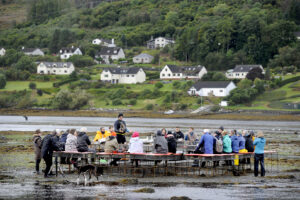Year
2020
Publisher
Random House
Author
Merlin Sheldrake
Annotation
Fungal networks can be tiny ephemeral puffs that live on little specks of dust or sprawl over ten square kilometres, weighing hundreds of tonnes, and reach the age of between two and eight thousand years. We are rarely able to see them, but they are inside us and all around us. Merlin Sheldrake is a biologist with the radical imagination of a poet. Sheldrake reveals how this wonderful mycorrhizal world and our entanglement/cospiracy with it could shift our understanding of living together. These extraordinary and sophisticated organisms put into question our concepts of individuality and intelligence and prompt us to think in new ways about what it means for organisms to ‘solve problems’, ‘communicate’, ‘make decisions’, ‘learn’ and ‘remember’.
Judith Wielander
A number of organisms with extreme tolerances have been sent into orbit, from bacterial spores to free-living algae, to rock-dwelling fungi, to tardigrades – microscopic animals known as 'water bears'. Some can survive if shielded from the damaging effects of solar radiation. But few, apart from a handful of lichen species, are able to survive in full space conditions, drenched in unfiltered cosmic rays. So remarkable are these lichens’ abilities that they have become model life forms for astrobiological research, ideal organisms 'to discern', as one researcher writes, "the limits and limitations of terrestrial life". It isn’t the first time lichens have helped humans to fathom the limits of life as we know it. Lichens are living riddles. Since the nineteenth century, they have provoked fierce debate about what constitutes an autonomous individual.The closer we get to lichens, the stranger they seem. To this day, lichens confuse our concept of identity and force us to question where one organism stops and another begins.
Imagine that you could pass through two doors at once. It’s inconceivable, yet fungi do it all the time. When faced with a forked path, fungal hyphae don’t have to choose one or the other. They can branch and take both routes. One can confront hyphae with microscopic labyrinths and watch how they nose their way around. If obstructed, they branch. After diverting themselves around an obstacle, the hyphal tips recover the original direction of their growth. They soon find the shortest path to the exit, just as my friend’s puzzle-solving slime moulds were able to find the quickest way out of the IKEA maze. If one follows the growing tips as they explore, it does something peculiar to one’s mind. One tip becomes two, becomes four, becomes eight – yet all remain connected in one mycelial network. Is this organism singular or plural, I find myself wondering, before I’m forced to admit that it is somehow, improbably.










